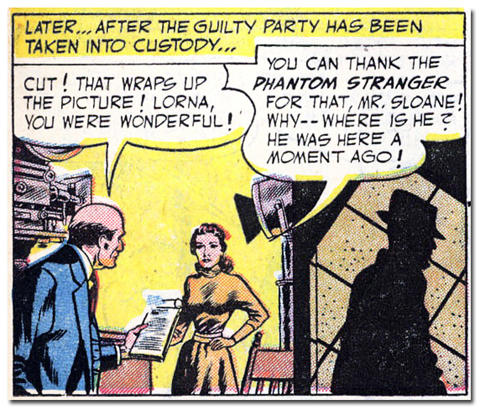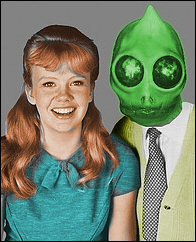In the early appearances of the Phantom Stranger the character was not so much mystical as a private detective. The Phantom Stranger investigated crimes that appeared to have a supernatural origin but were actually perpetrated by con artists. He was a free-lance ghost-buster with plots and stories that were much like those much later seen in the Scooby-Doo cartoons. The Stranger and the Scooby Gang shared similar themes in which someone would dress as a monster or ghost to frighten away people from a circus or resort so an unscrupulous business man could buy it cheaply or to swindle people out of money.
At the end of each adventure after the Phantom Stranger had solved the crime the players would suddenly notice that the Stranger had mysteriously vanished. While the impression was that the Stranger had magically dismissed himself there was always an "out" in the scene to allow the comic book company to claim in the event of complaints or Comics Code censorship that it was not accomplished by magic.
It is in the last issue of the 6-issue run of the Phantom Stranger's original series where the mundane explanations behind the adventures starts to break down a bit. In the story Horror In Miniature, Phantom Stranger #6 (v1, June-July 1953), a mining town is plagued by elves that vandalize equipment and attack the workers. The Phantom Stranger becomes involved and with the aid of one of the workers defeats the elves and drives them away. What is different about this story is that the culprits were not revealed to be using trickery or by being midgets in fanciful costumes. At the end of the tale the "elves" confessed to being mutated humans from the far future who had come back in time to take over the earth.
The art and story has many references to the mythological and it is my impression that the climax of the story may have been tweaked. It may be that the story was about legendary elves but in order to avoid Comics Code problems the creators had the invaders claim to being time travelers and not mystical creatures. The mining town was their entrance point into 1953 and the advance scout "elves" sought to destroy the iron works because it was deadly to them, as iron was to the faerie of legend. It is an explanation that is closer to science fiction than magic, but the overall impression is that it was intended that the Stranger was fighting legendary elves, particularly by the reference to iron being deadly to the touch. In all the other stories the Phantom Stranger revealed the villains in the end to be clever thieves and petty crooks.
More proof that the creators were weary of the rational resolution to the stories is seen at the end of this tale. As usual the Phantom Stranger does his mysterious exit thing from the scene, but with a difference. The difference being that is this instance the Stranger (wearing full medieval armor by the way), disappears from a wide opened area when the other protagonist of the story glances away for a moment. The creators did not leave a convenient way for the Phantom Stranger to have vanished from the field unless it was by some manner other than natural.
The next time the Stranger would appear in his own series he was acting as a fully empowered mystic who easily hopped dimensions, fought demons and monsters, conversed with gods and fired spells that burst like fireworks. In a change of tone from the 1950 series, any other-worldly creatures that were exposed to have been con men usually met a grisly, ironic death by supernatural means or the Stranger narrated a tale where 'fate' inevitably caused a suitable revenge to befall an evil-doer.
Tags: Phantom Stranger Seduction of the Innocent


























No comments:
Post a Comment
Moderation enabled only because of trolling, racist, homophobic hate-mongers.
Note: Only a member of this blog may post a comment.